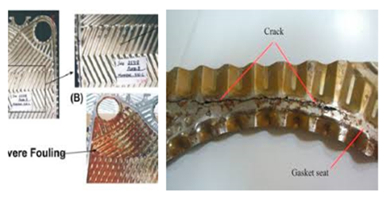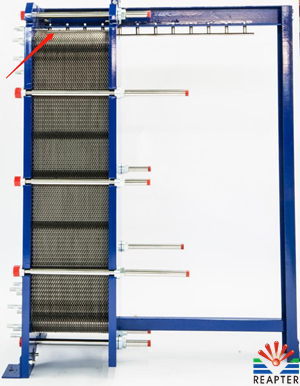Method for preventing electrochemical corrosion of detachable plate heat exchanger
In the detachable plate heat exchanger, the plates are mainly in contact with the upper and lower guide rods. The upper guide rods are generally H-shaped steel or I-beam steel, the material is carbon steel, and the plate materials are generally various grades of stainless steel. The plate and the upper guide The rods are in close contact. When stainless steel and carbon steel are in contact, the potential difference between stainless steel and carbon steel is obvious. The environment of the heat exchanger is generally a relatively humid or water environment, which forms an electrochemical primary battery. , An electrochemical reaction occurs between the two, and stainless steel produces intergranular corrosion. Normally, carbon steel corrodes in the environment.

(The picture comes from the Internet, if there is any infringement, please contact us to delete)
However, if it is in the environment of chloride ions (such as seawater), the corrosion of carbon steel is very slight, and pitting corrosion of stainless steel will occur, because the oxide layer protective film on the surface of stainless steel is penetrating The strong chloride ion will soon be destroyed, and local galvanic corrosion will occur. The metal in the passive state still has a certain reaction ability, that is, the dissolution and repair (passivation) of the passive film is in a dynamic equilibrium state. When the medium contains active blocking ions (commonly known as chloride ions), the equilibrium is destroyed and dissolution predominates. The reason is that chloride ions can preferentially adsorb on the passivation film, squeeze out the oxygen ions, and then combine with the cations in the passivation film to form soluble chloride, resulting in small corrosion at specific points of the newly exposed base metal The pits (the pore diameter is mostly 20 ~ 30µm). These small pits are called hole erosion nuclei, which can be understood as the active center generated by the hole erosion. Will accelerate the corrosion of stainless steel.
Qingdao reapter adopts a new way to separate the upper guide rod made of carbon steel from the heat exchange plate made of stainless steel. The specific method is:
 1. The upper guide bar is not in contact with the heat exchange plate, and cannot form an electrochemical reaction, delaying the corrosion of the heat exchange plate.
1. The upper guide bar is not in contact with the heat exchange plate, and cannot form an electrochemical reaction, delaying the corrosion of the heat exchange plate.
2. The guide rod part and the heat exchange plate change from point contact to line contact, and the positioning effect is better
Qingdao Reapter Heat Exchange Equipment Manufacturing Co., Ltd. is actively forging ahead, constantly updating its technology and upgrading its industry, and providing one-stop detachable plate heat exchanger equipment solutions.
Related information
- The purchase cost of heat exchanger is more important than the operation cost
- Sugar production with stainless steel plate heat exchanger in the overall role of the sugar industry production
- Chuanqing Drilling Engineering Company uses Repute plate and shell heat exchanger case
- Heat exchanger manufacturers introduce you to solve the problem of aging stainless steel plate heat exchanger gaskets
- The low-temperature waste heat recovery plate heat exchanger of the oil refining unit replaces the shell-and-tube heat exchanger with good results
- During the installation process of the plate heat exchanger, the choice of the interface form is also very important.
Relevant article
- Heat station supporting plate heat exchanger installation is a technical work, these points should be noted
- Sulfuric acid and other corrosive media for industrial plate heat exchanger requirements are what
- Simple and effective chemical cleaning method of coal chemical plate heat exchanger, can effectively improve efficiency
- A high-quality petrochemical plate heat exchanger in the production of what to consider
- These causes of chemical plate heat exchanger gasket aging you may not know
- Chemical plant plate heat exchanger, sulfuric acid cooling needs attention
- High-end plate heat exchanger customization, specifically for your special working conditions
- The working principle of gasket type industrial plate heat exchanger and the scenarios of its use are worth knowing in depth
- Still worrying about the wholesale price of industrial plate heat exchangers? An article to make you no longer tangled
- The original lubricant in the chemical plate heat exchanger plays so many roles!
Latest information
- Heat station supporting plate heat exchanger installation is a technical work, these points should be noted
- Sulfuric acid and other corrosive media for industrial plate heat exchanger requirements are what
- Simple and effective chemical cleaning method of coal chemical plate heat exchanger, can effectively improve efficiency
- A high-quality petrochemical plate heat exchanger in the production of what to consider
- These causes of chemical plate heat exchanger gasket aging you may not know
- Chemical plant plate heat exchanger, sulfuric acid cooling needs attention
- High-end plate heat exchanger customization, specifically for your special working conditions
- The working principle of gasket type industrial plate heat exchanger and the scenarios of its use are worth knowing in depth
- Still worrying about the wholesale price of industrial plate heat exchangers? An article to make you no longer tangled
- The original lubricant in the chemical plate heat exchanger plays so many roles!








